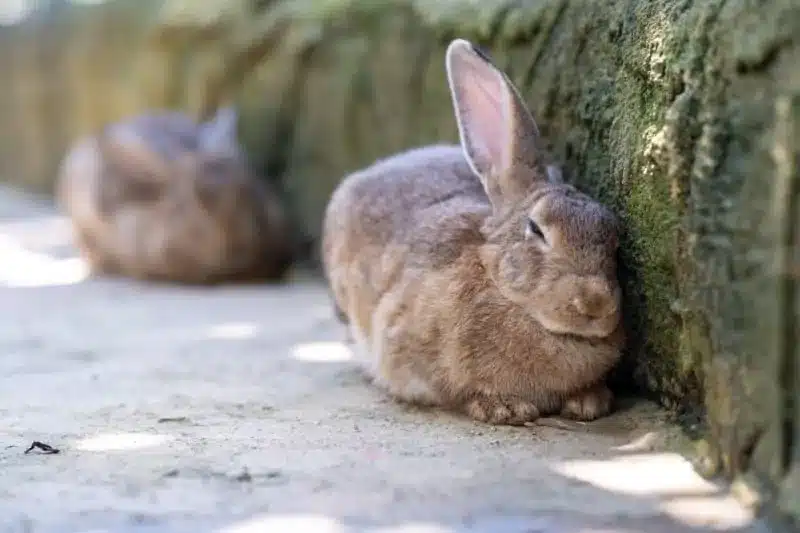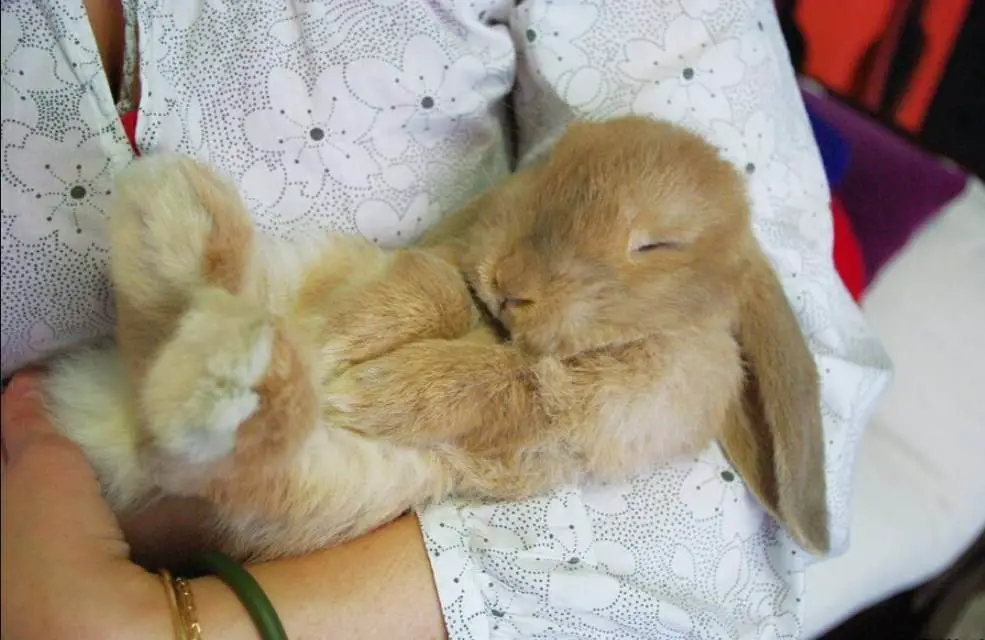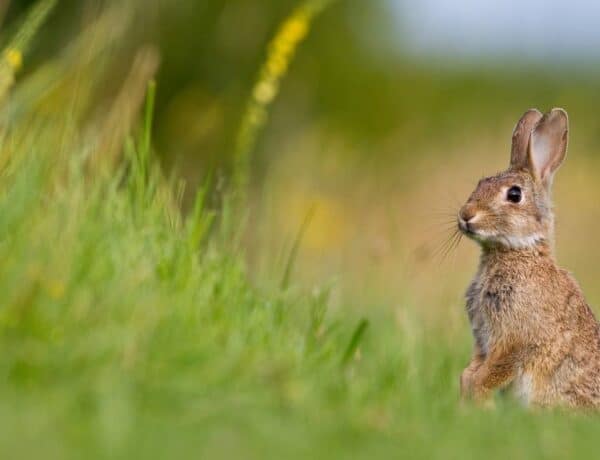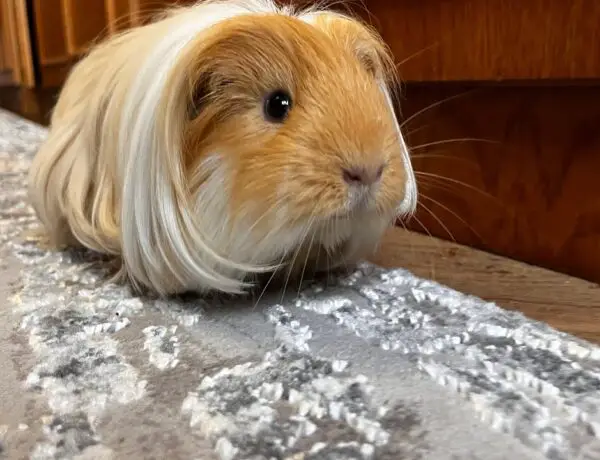Introduction
How Do Rabbits Sleep: Rabbits are intriguing creatures known for their unique behaviors, and their sleeping habits are no exception. If you’ve ever wondered how rabbits sleep, you’ll discover that their approach to slumber is quite different from that of humans and many other animals.
Rabbits are crepuscular animals, which means they are most active during the dawn and dusk hours. This natural behavior is linked to their survival instincts, as these twilight periods offer a mix of both light and darkness, reducing the risk of encountering predators. Consequently, rabbits have adapted their sleeping patterns to align with these active periods, allowing them to forage for food and socialize when the conditions are relatively safer.
Unlike humans who typically sleep for extended periods during the night, rabbits’ sleep is fragmented and often shorter. They engage in a behavior known as “catnapping,” where they take numerous short naps throughout the day and night. These naps usually last for just a few minutes at a time. This frequent napping pattern helps them stay alert to potential threats in their surroundings.
Interestingly, rabbits have the ability to sleep with their eyes open. This is due to their unique eye structure and positioning, which allows them to maintain a state of partial awareness even while asleep. This adaptation is crucial for their survival in the wild, where predators could strike at any moment.
The sleeping positions of rabbits can vary as well. They might stretch out, curl up, or lie on their sides, depending on their comfort and the environment. While their sleep duration might be relatively short, the total amount of sleep they accumulate during these brief naps can add up over the course of a day.

Do rabbits close their eyes when they sleep?
Rabbits sleep with their eyes open
They can sleep with their eyes closed too, but usually rabbits will only close their eyes when they are sleeping if they feel very safe. So you might think your rabbit never sleeps because they never close their eyes, but in reality they’re sneaking a nap right in front of you.
Rabbit Sleeping Patterns
Rabbits are crepuscular animals, which means they are most active during the dawn and dusk hours. This behavior is an adaptation that helps them avoid predators and find food more efficiently. In the wild, rabbits are highly alert and wary of potential threats, even while sleeping. Consequently, their sleeping patterns are notably different from those of humans and some other animals.
Partial Eye Closure
Unlike humans and some other animals that fully close their eyes when they sleep, rabbits tend to exhibit partial eye closure during their resting periods. This means that while they do not shut their eyes completely, their eyelids droop to a semi-closed position. This subtle eye position allows rabbits to quickly detect movements and potential dangers in their surroundings. This trait is essential for their survival, as rabbits are prey animals and need to remain vigilant even during sleep.
Vigilance and Survival
The reason behind rabbits’ partial eye closure lies in their evolutionary history and their role in the food chain. Rabbits have a wide array of predators, ranging from birds of prey to terrestrial carnivores. By keeping their eyes slightly open, rabbits can rapidly assess their environment for any signs of danger. This heightened vigilance helps them respond quickly to threats and increases their chances of escaping potential predators.
Domesticated Rabbits
Even domesticated rabbits, which are generally safer from natural predators, retain this instinctual behavior of partial eye closure during sleep. While they might feel safer in controlled environments, their innate tendencies remain largely unchanged due to their evolutionary history.
Do rabbits sleep at night?
Nope! Another question that people often ask is whether rabbits sleep mostly during the day or at night. And the answer is neither. They are crepuscular, meaning that they are most active at dusk and dawn.
Crepuscular Lifestyle
Rabbits are considered crepuscular animals, which means they are most active during the twilight hours of dawn and dusk. This behavior has evolutionary roots, serving as a survival strategy to avoid predators while also taking advantage of dim lighting to forage for food. As a result, rabbits often appear more awake and active during these times, leading to the misconception that they are not nighttime sleepers.
Nighttime Activity
Contrary to the notion that rabbits are entirely inactive at night, they do exhibit some level of movement and activity during the nighttime hours. In the wild, this behavior might involve brief periods of movement, feeding, or monitoring their surroundings. This is a cautious and adaptive behavior, allowing them to exploit available resources while minimizing exposure to nocturnal predators.
Domesticated Rabbits
Domesticated rabbits, on the other hand, might adjust their sleep patterns slightly due to the controlled environment they live in. While they still retain their crepuscular tendencies, domestic rabbits can adapt to their owners’ routines and lifestyle to some extent. If kept indoors, they might adjust their activity levels based on the household’s activity patterns, which often include more activity during the day and relative quietness at night.
Sleep Duration
Like all animals, rabbits require a certain amount of sleep to function properly. On average, rabbits sleep around 8 hours a day, but this sleep is not continuous. Their sleep patterns consist of short naps throughout the day and night, adding up to the total sleep time they need. This fragmented sleep pattern is also a result of their prey animal instincts, enabling them to remain alert to potential threats.
Light Sensitivity
Rabbits have sensitive eyes that are adapted to detect even the slightest movements and changes in lighting. This heightened sensitivity to light contributes to their behavior of being active during low light conditions. While rabbits may not sleep as deeply or continuously as humans do at night, they do experience sleep cycles that include both light and deep sleep stages.
How do rabbits like to sleep?
They can sleep in many positions, but they tend to prefer sitting or semi-sitting positions. This allows them to wake up quickly if something dangerous happens. Rabbits can also sleep on their sides or stomachs, but these positions make them more vulnerable to attack.
Sleep Postures
Rabbits are known for their diverse sleep postures, each of which provides insight into their physical comfort and their ability to stay alert to their surroundings. Some common sleep postures observed in rabbits include:
Flopped Over: One of the most endearing postures, rabbits often stretch out on their sides with their legs extended. This posture signifies relaxation and comfort, indicating that the rabbit feels safe and secure in its environment.
Curled Up: Similar to a ball, rabbits sometimes curl up with their legs tucked underneath them. This posture is believed to help conserve body heat and maintain a sense of protection by minimizing their vulnerability.
Stretched Out: In this posture, rabbits lie flat on their stomachs, legs outstretched behind them. This allows them to quickly jump up and escape if they perceive any threats, highlighting their prey animal instincts.
Lying on Their Backs: While less common, rabbits might occasionally lie on their backs. This posture usually occurs when they are in a completely relaxed state and feel utterly secure in their surroundings.
Safety and Comfort
Rabbits prioritize safety and comfort when it comes to sleep. In the wild, they are prey animals, constantly on the lookout for potential predators. As a result, their sleep preferences are tailored to ensure they can awaken and respond to danger swiftly. The choice of sleep posture often depends on their perception of their surroundings. For instance, a rabbit that feels secure in its environment might choose to stretch out or flop over, while a rabbit that is more cautious might curl up to stay alert.
Environmental Factors
Domesticated rabbits adapt their sleep habits to their environment. If rabbits are kept indoors, away from potential predators, they may feel more at ease and choose sleep postures that reflect comfort rather than vigilance. A safe and quiet living space can encourage rabbits to stretch out and adopt more relaxed sleep postures.
Rapid Eye Movement (REM) Sleep
Research has indicated that rabbits experience REM sleep, a sleep stage associated with dreaming in mammals. During REM sleep, rabbits might twitch, move their noses, or even kick their legs, suggesting they are indeed experiencing some form of dream activity. Despite these dream-like behaviors, they remain sensitive to their surroundings and can quickly wake if necessary.
What do rabbits do at night?
Sleeping through the night
Most rabbits will go to sleep between 10-12 pm. They’ll sleep until it’s time to wake up in the morning and start a new day. Like afternoon nap time, many rabbits will periodically get up to stretch and eat in the middle of the night.
Crepuscular Nature
To understand what rabbits do at night, it’s important to recognize their crepuscular nature. Crepuscular animals are most active during the periods of dawn and dusk, when the light is dimmer. Rabbits have evolved to follow this pattern as an adaptive strategy, allowing them to find food and avoid predators more effectively. While they are not strictly nocturnal, their crepuscular behavior means they remain active during the transition between day and night.
Nighttime Foraging
While rabbits are not primarily active during the dark hours, they do engage in some level of nighttime foraging. In the wild, rabbits may take advantage of the cover of darkness to feed on vegetation. This behavior is a survival mechanism, as it allows them to avoid potential predators while seeking out sustenance. Even in domestic settings, rabbits might nibble on hay or pellets during the night.
Brief Activity
If you happen to catch a glimpse of a rabbit during the night, you might observe brief bursts of activity. This could include hopping around their enclosure, grooming themselves, or investigating their surroundings. However, this activity is often short-lived, as rabbits tend to be more cautious and alert in low-light conditions due to their prey animal instincts.
Rest and Relaxation
Despite their crepuscular behavior, rabbits do spend a considerable amount of time resting and sleeping during the night. Their sleep patterns consist of short naps that help them conserve energy while maintaining awareness of their environment. Rabbits often adopt sleep postures that allow them to quickly respond to perceived threats. These postures can include curling up, stretching out, or flopping over, depending on their comfort and level of alertness.
Dreaming and REM Sleep
Research suggests that rabbits experience Rapid Eye Movement (REM) sleep, a stage associated with dreaming in mammals. During REM sleep, rabbits might display twitching movements, whisker twitches, or even kicking motions. This intriguing behavior indicates that rabbits might indeed have dream-like experiences during their sleep. However, they remain attuned to their surroundings, ready to awaken if necessary.
What colors can rabbits see?
Evidently, they can discriminate between the wavelengths we call “green” and “blue.” Although rabbits may not perceive green and blue the way we do, they *can* tell them apart. This means they have limited color vision, probably conferred by two different categories of cone cells (blue and green).
Color Perception in Rabbits
Contrary to popular belief, rabbits are not truly colorblind. However, their color vision is limited compared to that of humans. Rabbits possess a dichromatic color vision, which means they have two types of color receptors, or cones, in their eyes. These receptors are sensitive to blue-green and green-yellow wavelengths of light. As a result, rabbits are less able to perceive the red and orange spectrum of colors that humans can see.
Predominant Colors
The colors that rabbits perceive most vividly are those within the blue and green parts of the spectrum. This corresponds to the colors of plants and vegetation, which are central to a rabbit’s natural environment. The greens of leaves and grasses, as well as the blue hues of the sky, are likely more pronounced in a rabbit’s visual perception.
Limited Red and Orange Perception
Colors such as red and orange appear muted or may even appear as shades of brown or gray to rabbits. This is due to the absence of color receptors sensitive to these wavelengths in their eyes. Consequently, objects that are red or orange in human vision may not stand out to rabbits in the same way.
Adaptations for Survival
Rabbit vision is tailored to their evolutionary history as prey animals. Their sensitivity to blue and green wavelengths allows them to identify edible vegetation while avoiding potential dangers. The muted perception of red and orange may be less relevant in their natural habitat, as these colors are less commonly found in their surroundings.
Low-Light Adaptation
Rabbits also possess adaptations that make them well-suited for low-light conditions. Their eyes are positioned on the sides of their heads, providing them with a wide field of view that aids in detecting predators. While their color vision might not be as keen as humans’, their ability to detect motion and changes in lighting is highly developed, enhancing their ability to spot potential threats.
Do rabbits watch you sleep?
Your rabbit is keeping watch for you
They’ll loaf, or lay down near you, but stay more or less aware while you sleep. They’ll often be facing you as they watch over you, but usually, they’re actually keeping an eye and an ear out for potential threats.
Curious Creatures: Rabbits are naturally curious animals, and they are highly attuned to their environment. When they’ve established trust and comfort with their human caregivers, they may exhibit behavior that appears as if they are observing us. If you’ve noticed your rabbit gazing in your direction while you’re resting, it could be a result of their natural curiosity about your presence.
Bonding and Comfort: Rabbits form strong bonds with their human companions over time. When you’re nearby, your rabbit might find comfort in your presence. This sense of security may extend to your sleeping hours, even if they’re not actively watching you. It’s a reflection of the bond you’ve built and the feelings of companionship you share.
Awareness of Routine: Rabbits are creatures of habit and can be attuned to their human’s routines. If you have a regular sleep schedule, your rabbit might become accustomed to the times you rest. While they might not watch you sleep, they could be aware of the changes in your activity levels and the environment during those hours.
Nocturnal Activity: While rabbits are not strictly nocturnal animals, they are crepuscular, meaning they are most active during the dawn and dusk hours. If your rabbit has free range of a space close to your sleeping area, they might engage in their own activities during the night. This could lead to them being awake while you’re asleep, but it’s not necessarily a conscious act of “watching” you.
Comfort in Your Presence: Rabbits are social animals that seek companionship. If your rabbit has bonded with you and considers you a member of their social group, they might find comfort in your presence, whether you’re awake or asleep. This sense of security could lead to behaviors that appear as if they are observing you while you rest.
Do rabbits sleep in dark or light?
Rabbits need a contrast of light and darkness. A rabbit that lives in constant light can experience stress. In addition, their eyes can be damaged, and they’ll gain weight. Provide a dark area for your bunny to sleep and relax within.
Crepuscular Nature
Rabbits are known for their crepuscular behavior, which means they are most active during the twilight hours of dawn and dusk. This adaptation is believed to be a survival strategy that helps them avoid predators while also allowing them to forage for food more effectively. Due to their crepuscular nature, rabbits naturally gravitate towards dimmer lighting conditions, which are prevalent during these transitional times of day.
Light in the Wild
In the wild, rabbits are more active during the periods of low light provided by the rising or setting sun. This behavior allows them to navigate their environment with some degree of cover from potential predators. As prey animals, rabbits are attuned to changes in lighting and use this awareness to their advantage.
Safety and Sleep
When it comes to sleep, rabbits prioritize safety. In their natural habitat, they choose sleep environments that provide them with a sense of security. This often translates to selecting areas that are hidden, covered, or sheltered, where they can rest without being easily detected by predators. Their choice of sleep location might not always align with complete darkness, but rather with spots that offer safety and concealment.
Domesticated Rabbits
For domesticated rabbits, the sleeping environment can be influenced by their living conditions. If kept indoors, the lighting conditions might be more consistent, as artificial lighting often provides a steady source of illumination. However, rabbits still retain their innate instincts, which might lead them to seek out quiet, shaded, or covered areas for their rest.
Sleep Patterns
Rabbits typically have fragmented sleep patterns, consisting of short naps throughout the day and night. These brief sleep sessions allow them to rest and conserve energy while remaining vigilant to their surroundings. Even during their sleep, their senses remain attuned to any changes, helping them respond quickly to potential threats.
How often do rabbits poop?
200-300 poops per day
Average sized bunnies will make 200-300 poops per day. They should be uniform in size and shape which means rounded and pea to garbanzo sized. The size of your bunny won’t always predict the size of their poops.
Continuous Digestion
Unlike many animals, rabbits have a specialized digestive system that involves continuous digestion and a two-step process. This means that rabbits are almost always in the process of digesting their food. They consume a diet high in fiber, primarily consisting of hay and leafy greens, which requires a longer digestion period to extract nutrients effectively.
Cecotropes and Fecal Pellets
Rabbits produce two types of droppings: fecal pellets and cecotropes. Fecal pellets are the familiar round, dry droppings that are often seen in a rabbit’s living space. These droppings are typically not consumed by the rabbit and are considered waste.
Cecotropes, on the other hand, are nutrient-rich droppings that are produced in the cecum, a specialized part of the rabbit’s digestive tract. These cecotropes are soft, shiny, and resemble clusters of grapes. Unlike fecal pellets, cecotropes are re-ingested by the rabbit as part of their natural digestive process. This practice is known as coprophagy and is vital for rabbits to gain essential nutrients from their diet.
Frequency of Droppings
Rabbits exhibit a frequent and consistent pattern of dropping both fecal pellets and cecotropes. Fecal pellets are passed multiple times throughout the day, and you might notice them accumulating in their living space. The exact frequency varies based on factors such as the rabbit’s diet, age, and activity level. Young rabbits tend to have more frequent bowel movements.
Cecotropes, being a crucial part of their diet, are produced in the cecum during the night or early morning. Rabbits often consume cecotropes directly from their anus, a behavior that might go unnoticed due to their efficiency at doing so.
Health Indicators
Monitoring a rabbit’s droppings can provide insights into their health. Changes in the frequency, size, or consistency of droppings can be indicators of digestive or dietary issues. If you notice significant changes in your rabbit’s droppings, consulting a veterinarian who specializes in rabbit care is recommended.

Conclusion
The sleeping habits of rabbits are a fascinating example of how animals adapt to their environment and balance survival needs with rest. Their crepuscular nature, characterized by being most active during dawn and dusk, guides their fragmented sleep patterns. This adaptation ensures that rabbits can remain vigilant against potential threats while still obtaining the rest they need.
Rabbits’ ability to sleep with their eyes open and their inclination for short, frequent naps are remarkable strategies that have evolved over time to help them thrive in the wild. These behaviors allow them to stay connected to their surroundings and respond swiftly to changes, which is essential for avoiding predators and securing food.
Whether in the wild or captivity, understanding how rabbits sleep sheds light on their unique biology and offers a deeper appreciation for the diverse ways in which different species have developed their own survival strategies. As we continue to study and observe these small but complex creatures, we gain valuable insights into the intricate web of life and the extraordinary ways in which animals adapt to the challenges of their world.





No Comments